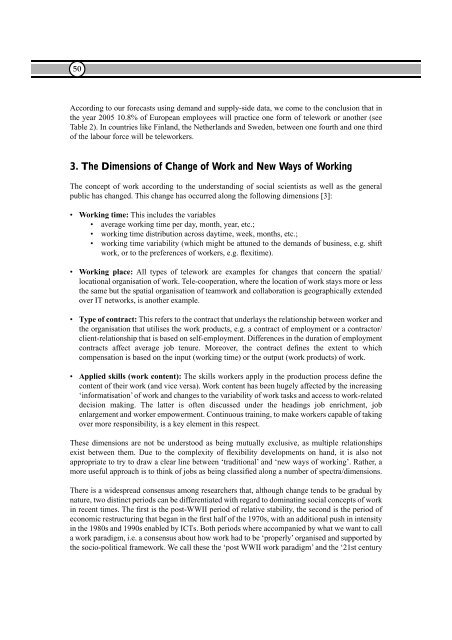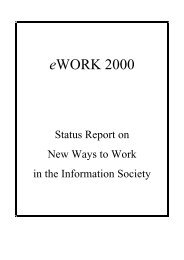Proceedings of 8th European Assembly on telework (Telework2001)
Proceedings of 8th European Assembly on telework (Telework2001)
Proceedings of 8th European Assembly on telework (Telework2001)
You also want an ePaper? Increase the reach of your titles
YUMPU automatically turns print PDFs into web optimized ePapers that Google loves.
50According to our forecasts using demand and supply-side data, we come to the c<strong>on</strong>clusi<strong>on</strong> that inthe year 2005 10.8% <str<strong>on</strong>g>of</str<strong>on</strong>g> <str<strong>on</strong>g>European</str<strong>on</strong>g> employees will practice <strong>on</strong>e form <str<strong>on</strong>g>of</str<strong>on</strong>g> <strong>telework</strong> or another (seeTable 2). In countries like Finland, the Netherlands and Sweden, between <strong>on</strong>e fourth and <strong>on</strong>e third<str<strong>on</strong>g>of</str<strong>on</strong>g> the labour force will be <strong>telework</strong>ers.3. The Dimensi<strong>on</strong>s <str<strong>on</strong>g>of</str<strong>on</strong>g> Change <str<strong>on</strong>g>of</str<strong>on</strong>g> Work and New Ways <str<strong>on</strong>g>of</str<strong>on</strong>g> WorkingThe c<strong>on</strong>cept <str<strong>on</strong>g>of</str<strong>on</strong>g> work according to the understanding <str<strong>on</strong>g>of</str<strong>on</strong>g> social scientists as well as the generalpublic has changed. This change has occurred al<strong>on</strong>g the following dimensi<strong>on</strong>s [3]:• Working time: This includes the variables• average working time per day, m<strong>on</strong>th, year, etc.;• working time distributi<strong>on</strong> across daytime, week, m<strong>on</strong>ths, etc.;• working time variability (which might be attuned to the demands <str<strong>on</strong>g>of</str<strong>on</strong>g> business, e.g. shiftwork, or to the preferences <str<strong>on</strong>g>of</str<strong>on</strong>g> workers, e.g. flexitime).• Working place: All types <str<strong>on</strong>g>of</str<strong>on</strong>g> <strong>telework</strong> are examples for changes that c<strong>on</strong>cern the spatial/locati<strong>on</strong>al organisati<strong>on</strong> <str<strong>on</strong>g>of</str<strong>on</strong>g> work. Tele-cooperati<strong>on</strong>, where the locati<strong>on</strong> <str<strong>on</strong>g>of</str<strong>on</strong>g> work stays more or lessthe same but the spatial organisati<strong>on</strong> <str<strong>on</strong>g>of</str<strong>on</strong>g> teamwork and collaborati<strong>on</strong> is geographically extendedover IT networks, is another example.• Type <str<strong>on</strong>g>of</str<strong>on</strong>g> c<strong>on</strong>tract: This refers to the c<strong>on</strong>tract that underlays the relati<strong>on</strong>ship between worker andthe organisati<strong>on</strong> that utilises the work products, e.g. a c<strong>on</strong>tract <str<strong>on</strong>g>of</str<strong>on</strong>g> employment or a c<strong>on</strong>tractor/client-relati<strong>on</strong>ship that is based <strong>on</strong> self-employment. Differences in the durati<strong>on</strong> <str<strong>on</strong>g>of</str<strong>on</strong>g> employmentc<strong>on</strong>tracts affect average job tenure. Moreover, the c<strong>on</strong>tract defines the extent to whichcompensati<strong>on</strong> is based <strong>on</strong> the input (working time) or the output (work products) <str<strong>on</strong>g>of</str<strong>on</strong>g> work.• Applied skills (work c<strong>on</strong>tent): The skills workers apply in the producti<strong>on</strong> process define thec<strong>on</strong>tent <str<strong>on</strong>g>of</str<strong>on</strong>g> their work (and vice versa). Work c<strong>on</strong>tent has been hugely affected by the increasing‘informatisati<strong>on</strong>’ <str<strong>on</strong>g>of</str<strong>on</strong>g> work and changes to the variability <str<strong>on</strong>g>of</str<strong>on</strong>g> work tasks and access to work-relateddecisi<strong>on</strong> making. The latter is <str<strong>on</strong>g>of</str<strong>on</strong>g>ten discussed under the headings job enrichment, jobenlargement and worker empowerment. C<strong>on</strong>tinuous training, to make workers capable <str<strong>on</strong>g>of</str<strong>on</strong>g> takingover more resp<strong>on</strong>sibility, is a key element in this respect.These dimensi<strong>on</strong>s are not be understood as being mutually exclusive, as multiple relati<strong>on</strong>shipsexist between them. Due to the complexity <str<strong>on</strong>g>of</str<strong>on</strong>g> flexibility developments <strong>on</strong> hand, it is also notappropriate to try to draw a clear line between ‘traditi<strong>on</strong>al’ and ‘new ways <str<strong>on</strong>g>of</str<strong>on</strong>g> working’. Rather, amore useful approach is to think <str<strong>on</strong>g>of</str<strong>on</strong>g> jobs as being classified al<strong>on</strong>g a number <str<strong>on</strong>g>of</str<strong>on</strong>g> spectra/dimensi<strong>on</strong>s.There is a widespread c<strong>on</strong>sensus am<strong>on</strong>g researchers that, although change tends to be gradual bynature, two distinct periods can be differentiated with regard to dominating social c<strong>on</strong>cepts <str<strong>on</strong>g>of</str<strong>on</strong>g> workin recent times. The first is the post-WWII period <str<strong>on</strong>g>of</str<strong>on</strong>g> relative stability, the sec<strong>on</strong>d is the period <str<strong>on</strong>g>of</str<strong>on</strong>g>ec<strong>on</strong>omic restructuring that began in the first half <str<strong>on</strong>g>of</str<strong>on</strong>g> the 1970s, with an additi<strong>on</strong>al push in intensityin the 1980s and 1990s enabled by ICTs. Both periods where accompanied by what we want to calla work paradigm, i.e. a c<strong>on</strong>sensus about how work had to be ‘properly’ organised and supported bythe socio-political framework. We call these the ‘post WWII work paradigm’ and the ‘21st century








